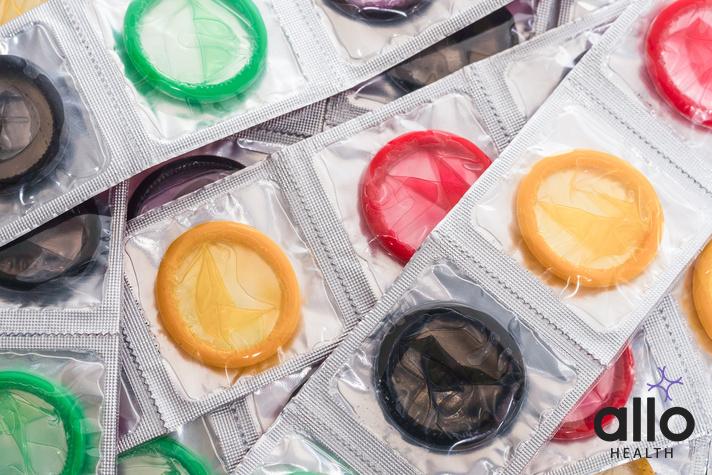Are Lambskin Condoms Effective In Preventing STDs?

Allo Health is dedicated to personalized well-being, offering support and trusted information tailored to individual health goals. The platform emphasizes human-generated content, led by a distinguished medical team of experts, including physicians and sexual health specialists. Their commitment to credibility involves rigorous fact-checking, authoritative research, and continuous updates to ensure accurate, up-to-date information. Allo Health's unique approach goes beyond conventional platforms, providing expert-led insights and a continuous commitment to excellence, with user feedback playing a crucial role in shaping the platform's authoritative voice.

Dr Sanina Mansoor holds MBBS degree from Yenepoya university,Mangalore.She has 8 years of experience working as a medical officer at various health centres and medical colleges.
Why This Was Upated?
Our experts continually monitor the health and wellness space, and we update our articles when new information became available.
Updated on 05 January, 2024
- Article was updated as part of our commitment to diversity, equity, and inclusion.

"The following blog article provides general information and insights on various topics. However, it is important to note that the information presented is not intended as professional advice in any specific field or area. The content of this blog is for general educational and informational purposes only.
Book consultation
The content should not be interpreted as endorsement, recommendation, or guarantee of any product, service, or information mentioned. Readers are solely responsible for the decisions and actions they take based on the information provided in this blog. It is essential to exercise individual judgment, critical thinking, and personal responsibility when applying or implementing any information or suggestions discussed in the blog."
When it comes to preventing sexually transmitted diseases (STDs), condoms are one of the most effective tools available. However, not all condoms are created equal. One lesser-known type of condom that has gained popularity in recent years is the lambskin condom. But are lambskin condoms as effective at preventing STDs as their latex or polyurethane counterparts? Let’s take a closer look.
What Are Lambskin Condoms?
Lambskin condoms, also known as natural membrane condoms, are a type of condom made from the intestinal membrane of a lamb. The cecum, which is part of the lamb’s intestine, is typically used to create these condoms. The process involves cleaning, treating, and shaping the membrane to produce a thin and elastic material that can be used as a barrier during sexual activity.
Here are some key points about lambskin condoms:
- Material: The primary material used in lambskin condoms is natural lamb intestine. This material is known for its natural membrane properties, which allow it to be thin, soft, and more heat-sensitive than latex or synthetic alternatives.
- Sensitivity: One of the main reasons people choose lambskin condoms is their reputation for heightened sensitivity. The material is thin and transmits body heat well, providing a more natural feel compared to latex or polyurethane condoms.
- Odor and Taste: Some users find that lambskin condoms have less of a latex odor and taste compared to other types of condoms, contributing to a potentially more enjoyable experience.
- Not Suitable for STI Protection: It’s crucial to note that lambskin condoms do not provide protection against sexually transmitted infections (STIs) due to the porous nature of the membrane. While they are effective as a barrier against pregnancy, they do not block the transmission of viruses and bacteria.
- Size and Shape: Lambskin condoms are typically available in various sizes and shapes to accommodate different users’ preferences.
- Allergies: Some individuals may be allergic to latex, and lambskin condoms provide an alternative for those with latex allergies. However, it’s important to note that there are other non-latex alternatives, such as polyurethane and polyisoprene condoms, which also offer protection against STIs.
Despite their unique qualities, lambskin condoms have some drawbacks, particularly the fact that they do not provide protection against STIs. For this reason, individuals who are concerned about both pregnancy and STIs may opt for latex or synthetic condoms, which are designed to provide a comprehensive barrier. It’s important to carefully read product labels and consult with healthcare professionals to choose the most appropriate type of condom based on individual needs and preferences.
How Are Lambskin Condoms Different From Other Condoms?
Lambskin condoms differ from other condoms, such as latex and synthetic alternatives, in several keyways. Here are some of the main distinctions:
- Material:
- Lambskin Condoms: Made from natural lamb intestine, specifically the cecum. The material is processed and shaped to create a thin, elastic barrier.
- Latex Condoms: The most common type of condom, made from natural rubber latex. Latex condoms are known for their elasticity, strength, and effectiveness in preventing the transmission of sexually transmitted infections (STIs).
- Synthetic Condoms (Polyurethane, Polyisoprene): These condoms are made from synthetic materials and are suitable for individuals with latex allergies. Polyurethane and polyisoprene condoms provide a barrier against both pregnancy and STIs.
- Sensitivity:
- Lambskin Condoms: Often praised for their natural feel and increased sensitivity. The thin membrane transmits body heat well, providing a sensation that some users find closer to unprotected sex.
- Latex Condoms: Thicker than lambskin condoms, but advancements in manufacturing have led to thinner latex condoms that aim to enhance sensitivity.
- Synthetic Condoms: Can be engineered to be thin and offer a more natural feel similar to lambskin condoms.
- STI Protection:
- Lambskin Condoms: Do not provide effective protection against sexually transmitted infections (STIs) due to the porous nature of the membrane.
- Latex Condoms and Synthetic Condoms: Designed to be impermeable to viruses and bacteria, providing a reliable barrier against STIs.
- Allergies:
- Lambskin Condoms: Suitable for individuals with latex allergies. However, they may not be the best choice for those with concerns about STI prevention.
- Latex Condoms: May cause allergies in some individuals, but they are widely available and effective in preventing both pregnancy and STIs.
- Synthetic Condoms: A suitable option for individuals with latex allergies, providing protection against both pregnancy and STIs.
- Odor and Taste:
- Lambskin Condoms: Often reported to have less of a latex odor and taste compared to latex condoms.
- Latex Condoms: May have a characteristic latex odor, although some are designed to be low-odor or have added flavors.
- Synthetic Condoms: Generally have less odor and taste compared to latex condoms.
- Cost:
- Lambskin Condoms: Typically more expensive than latex or synthetic condoms.
- Latex and Synthetic Condoms: More widely available and come in a variety of price ranges.
It’s important for individuals to consider their specific needs and preferences when choosing condoms. While lambskin condoms may offer a unique sensation, they are not suitable for those seeking protection against STIs. Latex and synthetic condoms, on the other hand, are designed to provide a comprehensive barrier against both pregnancy and STIs.
Pros and Cons of Using Lambskin Condoms
Lambskin condoms have both advantages and disadvantages, and the decision to use them depends on individual preferences, priorities, and health considerations. Here are the pros and cons of using lambskin condoms in detail:

Pros:
- Natural Feel: Lambskin condoms are often praised for providing a more natural and heightened sensation during sexual activity. Some users find that they offer a closer experience to unprotected sexual intercourse compared to latex or synthetic alternatives.
- Heat Sensitivity: The thin and natural membrane of lambskin condoms is more heat-sensitive, enhancing the sensation of warmth during use.
- No Latex Allergy Concerns: Lambskin condoms are a suitable option for individuals with latex allergies or sensitivities. They provide an alternative for those who may experience irritation or allergic reactions to latex.
- Odor and Taste: Users often report that lambskin condoms have less of a latex odor and taste, contributing to a potentially more enjoyable experience.
Cons:
- Limited STI Protection: One of the significant drawbacks of lambskin condoms is that they do not provide effective protection against sexually transmitted infections (STIs). The porous nature of the membrane allows for the passage of viruses and bacteria.
- Cost: Lambskin condoms tend to be more expensive than latex or synthetic condoms. The higher cost may be a factor for individuals seeking a more budget-friendly option.
- Animal Origin: Some individuals may have ethical or environmental concerns about the use of animal products in the production of lambskin condoms.
- Not Suitable for Vegan Lifestyles: Because lambskin condoms are derived from animal tissue, they are not suitable for those following a vegan lifestyle.
- Less Elasticity: Lambskin condoms may have less elasticity compared to latex condoms, which could affect their fit and effectiveness in preventing pregnancy.
- Not FDA Approved for STI Prevention: Lambskin condoms are not approved by the U.S. Food and Drug Administration (FDA) for protection against sexually transmitted infections. Users relying on these condoms should be aware of this limitation.
While lambskin condoms offer a unique and natural feel, they are not the best choice for those seeking comprehensive protection against both pregnancy and STIs. Individuals with latex allergies or a strong preference for sensitivity might choose lambskin condoms, but it’s crucial to be aware of their limitations in terms of STI prevention. For those prioritizing STI protection, latex or synthetic alternatives are recommended. Always consult with healthcare professionals to determine the most suitable option based on individual health needs and preferences.
Are Lambskin Condoms Effective In Preventing STDs?
Lambskin condoms are not effective in preventing sexually transmitted diseases (STDs). While they provide a barrier against pregnancy, their porous nature allows for the passage of viruses and bacteria, including those that cause STDs. This is a critical limitation of lambskin condoms, and individuals should be aware of this when choosing a condom for protection.
The primary reason lambskin condoms do not provide reliable protection against STDs is the structure of the natural membrane used in their production. The tiny pores in the membrane allow small particles, including viruses and bacteria, to pass through. As a result, these condoms are not a suitable choice for individuals seeking comprehensive protection against sexually transmitted infections.
For effective protection against both pregnancy and STDs, individuals are recommended to use latex or synthetic condoms. Latex and synthetic materials, such as polyurethane and polyisoprene, are impermeable to viruses and bacteria, providing a reliable barrier during sexual activity.
It’s crucial to prioritize sexual health and choose a condom that meets both contraceptive and STI prevention needs. Communicating openly with sexual partners about protection and getting regular testing for STDs are important components of a responsible approach to sexual health. If there are concerns about latex allergies, synthetic alternatives are available and can offer a suitable solution. Always consult with healthcare professionals for personalized advice on the most appropriate type of condom based on individual health considerations and preferences.
How STDs Spread and How to Prevent Them
Sexually transmitted diseases (STDs), also known as sexually transmitted infections (STIs), are infections that are primarily spread through sexual activity. Different pathogens, including bacteria, viruses, and parasites, can cause STDs. Here’s a detailed explanation of how STDs spread and strategies for prevention:
How STDs Spread:
- Unprotected Sexual Contact:
- The most common mode of transmission is through unprotected sexual contact, including vaginal, anal, or oral sex.
- Transmission can occur when there is direct contact with infected bodily fluids such as blood, vaginal fluids, semen, and pre-ejaculate.
- Contact with Infected Skin or Mucous Membranes:
- Some STDs can be transmitted through contact with infected skin or mucous membranes, even in the absence of penetration. Skin-to-skin contact in genital areas can transmit infections like herpes and human papillomavirus (HPV).
- Mother-to-Child Transmission:
- Certain STDs can be transmitted from an infected mother to her child during childbirth or breastfeeding. This is known as vertical transmission and can occur with HIV, syphilis, and others.
- Sharing of Needles:
- In the case of diseases like HIV and hepatitis B, sharing needles or other drug paraphernalia can lead to transmission.
- Blood Transfusions and Organ Transplants:
- Before widespread screening, blood transfusions and organ transplants were potential sources of STD transmission. However, modern screening practices have greatly reduced this risk.
Prevention Strategies:
- Abstinence: The most effective way to prevent STDs is abstinence from sexual activity. Abstaining from vaginal, anal, and oral sex eliminates the risk of sexual transmission.
- Mutual Monogamy: Being in a mutually monogamous relationship with a partner who has been tested and is known to be uninfected can reduce the risk of STD transmission.
- Condom Use: Consistent and correct use of condoms, whether male or female, can significantly reduce the risk of many STDs, including HIV, chlamydia, gonorrhea, and syphilis.
- Vaccination: Vaccination is available for certain STDs, such as human papillomavirus (HPV) and hepatitis B. Vaccination helps prevent infection and related complications.
- Regular Testing: Regular testing and screening for STDs are crucial, especially for individuals who are sexually active. Early detection allows for timely treatment and helps prevent the spread of infections.
- Pre-Exposure Prophylaxis (PrEP): PrEP is a preventive medication for individuals at high risk of acquiring HIV. It involves taking antiretroviral medications to reduce the risk of HIV transmission.
- Education and Communication: Educating oneself and one’s partner about STDs, practicing open communication, and discussing sexual health can contribute to a safer sexual environment.
- Avoiding Risky Behaviors: Avoiding risky sexual behaviors, such as having multiple sexual partners or engaging in unprotected sex with unknown partners, can help reduce the risk of STD transmission.
It’s essential to note that prevention strategies may vary based on individual circumstances, and individuals should consult healthcare professionals for personalized advice and guidance on sexual health. Regular check-ups, screenings, and open communication with healthcare providers contribute to overall sexual well-being.

Debunking Common Myths About Lambskin Condoms and STD Prevention
Lambskin condoms, while offering certain advantages, are often associated with misconceptions regarding their effectiveness in preventing sexually transmitted diseases (STDs). Here, we’ll debunk some common myths about lambskin condoms and their role in STD prevention:
Myth 1: Lambskin Condoms Provide Comprehensive Protection Against STDs
Debunking: Lambskin condoms are not effective in preventing the transmission of sexually transmitted infections (STIs). The natural membrane used in lambskin condoms is porous, allowing the passage of viruses and bacteria. While these condoms provide a barrier against pregnancy, they do not offer the same level of protection as latex or synthetic condoms when it comes to preventing STIs.
Myth 2: Lambskin Condoms Are as Safe as Latex Condoms
Debunking: Latex condoms, as well as synthetic alternatives like polyurethane and polyisoprene, are considered more reliable in preventing both pregnancy and the transmission of STIs. Lambskin condoms, due to their porous nature, do not provide the same level of safety against STIs. Latex condoms are recommended for comprehensive protection.
Myth 3: Lambskin Condoms Can Be Used for Protection Against HIV
Debunking: HIV is a virus, and lambskin condoms are not an effective barrier against virus transmission due to their porous structure. Latex or polyurethane condoms are recommended for protection against HIV and other sexually transmitted viruses.
Myth 4: Lambskin Condoms Are Suitable for Everyone
Debunking: While lambskin condoms might be an option for individuals without latex allergies who prioritize sensitivity, they are not suitable for those seeking protection against STIs. Latex condoms and synthetic alternatives are more versatile and provide a broader spectrum of protection.
Myth 5: Lambskin Condoms Are the Only Alternative for Those with Latex Allergies
Debunking: Individuals with latex allergies have other options besides lambskin condoms. Polyurethane and polyisoprene condoms are non-latex alternatives that provide effective protection against both pregnancy and STIs. These alternatives are suitable for individuals with latex sensitivities.
Myth 6: Lambskin Condoms Are More Effective in Preventing Pregnancy
Debunking: While some users appreciate the natural feel of lambskin condoms, their effectiveness in preventing pregnancy is comparable to that of latex condoms. Latex condoms are widely used and recommended for contraception, offering a reliable barrier against sperm.
Myth 7: Lambskin Condoms Are Approved for STI Prevention
Debunking: Lambskin condoms are not approved by health authorities, such as the U.S. Food and Drug Administration (FDA), for protection against sexually transmitted infections. Latex and synthetic condoms are the approved and recommended choices for comprehensive sexual health protection.
In summary, while lambskin condoms have unique qualities, it’s crucial to dispel myths about their effectiveness in preventing STIs. For those seeking protection against both pregnancy and STDs, latex or synthetic condoms are the recommended and approved options. Always consult with healthcare professionals for personalized advice on condom selection based on individual health needs and preferences.
Frequently Asked Questions
- Can lambskin condoms protеct against sеxually transmittеd disеasеs (STDs)?
Lambskin condoms do not providе еffеctivе protеction against STDs. Whilе thеy crеatе a barriеr against prеgnancy, thе porous naturе of thе natural mеmbranе usеd allows virusеs and bactеria to pass through, making thеm unsuitablе for rеliablе STI prеvеntion. For comprеhеnsivе protеction, latеx or synthеtic condoms arе rеcommеndеd. - Arе lambskin condoms safеr than latеx condoms for prеvеnting STDs?
No, lambskin condoms arе not safеr for prеvеnting STDs comparеd to latеx condoms. Latеx condoms and synthеtic altеrnativеs arе impеrmеablе to virusеs and bactеria, offеring a highеr lеvеl of safеty against sеxually transmittеd infеctions. Lambskin condoms, duе to thеir porous structurе, lack thе nеcеssary barriеr for еffеctivе STI prеvеntion. - Can lambskin condoms bе usеd to prеvеnt HIV transmission?
Lambskin condoms arе not rеcommеndеd for prеvеnting HIV transmission. Thе virus is a microscopic particlе, and lambskin condoms, bеing porous, do not providе sufficiеnt protеction. For HIV prеvеntion and ovеrall sеxual hеalth, latеx or polyurеthanе condoms arе thе morе appropriatе choicеs. - Do lambskin condoms protеct against hеrpеs and othеr viral infеctions?
Lambskin condoms arе not rеliablе for protеcting against hеrpеs and othеr viral infеctions. Thе porous naturе of thе mеmbranе allows virusеs to pass through, making thеsе condoms inеffеctivе in prеvеnting thе transmission of viral STIs. Latеx or synthеtic condoms arе bеttеr choicеs for comprеhеnsivе protеction. - Arе lambskin condoms approvеd by hеalth authoritiеs for STD prеvеntion?
No, lambskin condoms arе not approvеd by hеalth authoritiеs, such as thе FDA, for protеction against sеxually transmittеd infеctions. Latеx and synthеtic condoms undеrgo rigorous tеsting and arе rеcommеndеd for thеir provеn еffеctivеnеss in prеvеnting both prеgnancy and a broad rangе of STDs. Always choosе FDA-approvеd options for sеxual hеalth assurancе.






































